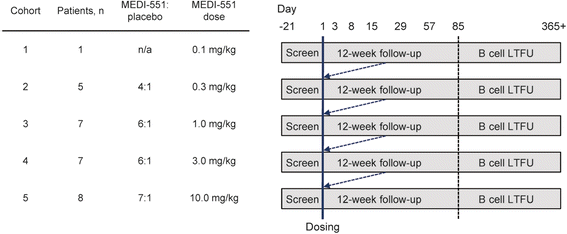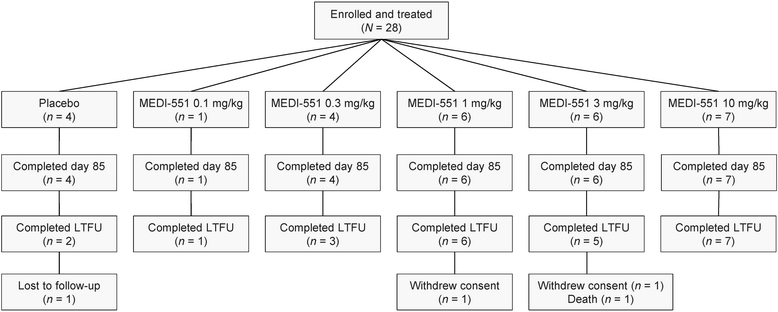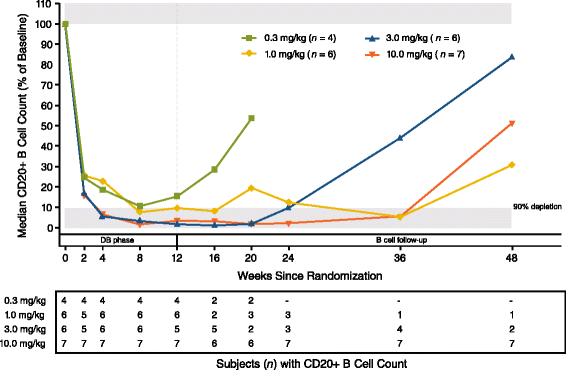Safety and tolerability of an anti-CD19 monoclonal antibody, MEDI-551, in subjects with systemic sclerosis: a phase I, randomized, placebo-controlled, escalating single-dose study
- PMID: 27267753
- PMCID: PMC4895815
- DOI: 10.1186/s13075-016-1021-2
Safety and tolerability of an anti-CD19 monoclonal antibody, MEDI-551, in subjects with systemic sclerosis: a phase I, randomized, placebo-controlled, escalating single-dose study
Abstract
Background: Systemic sclerosis (SSc) is a clinically heterogeneous, life-threatening disease characterized by fibrosis, microvasculopathy, and autoimmunity. Extensive nonclinical and clinical data implicate B cells in the pathogenesis of SSc. MEDI-551 is an investigational humanized monoclonal antibody that targets the B cell surface antigen CD19 and mediates antibody-dependent, cell-mediated cytotoxicity of B cells. This clinical study evaluated the safety and tolerability, pharmacokinetics, and pharmacodynamics of MEDI-551 in subjects with SSc.
Methods: This phase I multicenter, randomized, double-blind, placebo-controlled, single escalating dose study enrolled adult subjects with either limited or diffuse cutaneous SSc. A single intravenous dose of MEDI-551 was administered, and safety and tolerability were evaluated. MEDI-551 pharmacokinetics (PK), pharmacodynamics, and immunogenicity were also assessed. Safety assessments included the incidence of adverse events and changes in clinical and laboratory results. MEDI-551 serum concentrations, effects on circulating and tissue B cells and plasma cells (PCs), and antidrug antibodies were analyzed. Modified Rodnan skin score (MRSS) and pulmonary function tests were used to explore the clinical effect of MEDI-551.
Results: The study enrolled 28 subjects with SSc (mean age, 47.3 years; 67.9 % female). Twenty-four received a single dose of MEDI-551 (0.1-10.0 mg/kg) and four received placebo. Treatment-emergent adverse events (TEAEs) occurred in 95.8 % of subjects in the MEDI-551 group and in 75.0 % of subjects in the placebo group; the majority of TEAEs were mild or moderate in severity. Two serious adverse events were considered possibly related to the study drug. One death, deemed not related to the study drug, occurred in a MEDI-551-treated subject. MEDI-551 exhibited linear PK in the dose range of 1.0 to 10.0 mg/kg, and more rapid clearance at lower doses. Dose-dependent depletion of circulating B cells and plasma cells was observed. MRSS assessments suggest a possible clinical effect of MEDI-551 on affected skin.
Conclusions: A single escalating dose of MEDI-551 was tolerable and safe in this subject population. B cell depletion was achieved and was dose dependent. A signal of clinical effect was observed. Based on these results, further investigation of MEDI-551 as a disease-modifying treatment for SSc is warranted.
Trial registration: www.clinicaltrials.gov identifier, NCT00946699 ; registered 23 July 2009.
Keywords: B cells; CD19; Pharmacodynamics; Pharmacokinetics; Scleroderma; Systemic sclerosis.
Figures





References
-
- van den Hoogen F, Khanna D, Fransen J, Johnson SR, Baron M, Tyndall A, et al. 2013 classification criteria for systemic sclerosis: an American College of Rheumatology/European League against Rheumatism collaborative initiative. Arthritis Rheum. 2013;65:2737–47. doi: 10.1002/art.38098. - DOI - PMC - PubMed
Publication types
MeSH terms
Substances
Associated data
LinkOut - more resources
Full Text Sources
Other Literature Sources
Medical

